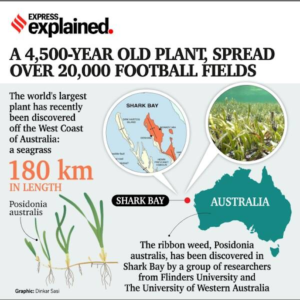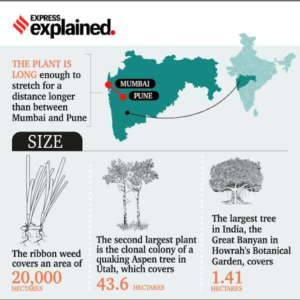In news–Rubber weed, the world’s largest plant was recently discovered off the West Coast of Australia, a seagrass 180 km in length.
About the Ribbon weed–
- The ribbon weed, or Posidonia australis, has been discovered in Shark Bay by a group of researchers from Flinders University and The University of Western Australia.
- These researchers have also found that the plant is 4,500 years old, is sterile, has double the number of chromosomes than other similar plants, and has managed to survive the volatile atmosphere of the shallow Shark Bay.
- Shark Bay is a World Heritage Site in the Gascoyne region of Western Australia.
- The 23,000-square-kilometre area is located approximately 800 kilometres north of Perth, on the westernmost point of the Australian continent.

- The ribbon weed covers an area of 20,000 hectares.
- The next on the podium, the second largest plant, is the clonal colony of a quaking Aspen tree in Utah (USA), which covers 43.6 hectares.
- The largest tree in India, the Great Banyan in Howrah’s Botanical Garden, covers 1.41 hectares.
- The existence of the seagrass was known, but that it is one single plant was not known.
- However, researchers have got to know that ribbon weed is just one plant that has expanded over 180km in Shark Bay, making it the largest known plant on earth.

How did it grow, and survive for so long?
- Ribbon weed rhizomes can usually grow to around 35cm per year, which is how the scientists arrived at its lifespan of 4,5000 years.
- The researchers found that the ribbon weed cannot spread its seeds, something that helps plants overcome environmental threats.
- Also, Shark Bay sees fluctuations in temperature and salinity and gets a lot of light, conditions challenging for any plant.
- Yet the ribbon weed has managed to survive, and a part of the reason may be that it is a polyploid – instead of taking half-half genome from both parents, it took 100 percent, something not unheard of in plants.
- Therefore, this ribbon weed has twice the number of chromosomes other plants of the same variety have.
- As per researchers, Polyploid plants often reside in places with extreme environmental conditions, are often sterile, but can continue to grow if left undisturbed, and this giant seagrass has done just that.
















